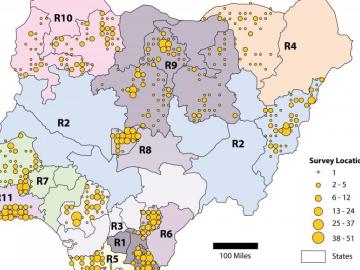Filter News
Area of Research
- (-) Computer Science (10)
- (-) Isotope Development and Production (1)
- (-) National Security (8)
- (-) Renewable Energy (2)
- Advanced Manufacturing (15)
- Biological Systems (2)
- Biology and Environment (32)
- Building Technologies (7)
- Chemical and Engineering Materials (1)
- Clean Energy (152)
- Climate and Environmental Systems (4)
- Computational Biology (1)
- Computational Engineering (2)
- Electricity and Smart Grid (1)
- Energy Sciences (2)
- Fossil Energy (1)
- Fusion and Fission (4)
- Fusion Energy (8)
- Isotopes (5)
- Materials (75)
- Materials for Computing (10)
- Mathematics (1)
- Neutron Data Analysis and Visualization (2)
- Neutron Science (35)
- Nuclear Science and Technology (18)
- Nuclear Systems Modeling, Simulation and Validation (2)
- Quantum information Science (3)
- Sensors and Controls (2)
- Supercomputing (41)
- Transportation Systems (2)
News Type
News Topics
- Artificial Intelligence (4)
- Big Data (5)
- Buildings (1)
- Computer Science (11)
- Coronavirus (1)
- Cybersecurity (1)
- Energy Storage (1)
- Environment (2)
- Grid (3)
- High-Performance Computing (1)
- Hydropower (1)
- Irradiation (1)
- Machine Learning (3)
- Quantum Science (1)
- Security (1)
- Summit (1)
- Sustainable Energy (2)
- Transportation (1)
Media Contacts

Oak Ridge National Laboratory researchers have developed a method to simplify one step of radioisotope production — and it’s faster and safer.

Although more than 92,000 dams populate the country, the vast majority — about 89,000 — do not generate electricity through hydropower.

Oak Ridge National Laboratory, University of Tennessee and University of Central Florida researchers released a new high-performance computing code designed to more efficiently examine power systems and identify electrical grid disruptions, such as

Oak Ridge National Laboratory researchers have created a technology that more realistically emulates user activities to improve cyber testbeds and ultimately prevent cyberattacks.

To minimize potential damage from underground oil and gas leaks, Oak Ridge National Laboratory is co-developing a quantum sensing system to detect pipeline leaks more quickly.

Oak Ridge National Laboratory researchers designed and field-tested an algorithm that could help homeowners maintain comfortable temperatures year-round while minimizing utility costs.

Oak Ridge National Laboratory scientists helped count the population of Nigeria – all without leaving the lab.

Oak Ridge National Laboratory’s high-resolution population distribution database, LandScan USA, became permanently available to researchers in time to aid the response to the novel coronavirus pandemic.

A novel approach developed by scientists at ORNL can scan massive datasets of large-scale satellite images to more accurately map infrastructure – such as buildings and roads – in hours versus days.

To better determine the potential energy cost savings among connected homes, researchers at Oak Ridge National Laboratory developed a computer simulation to more accurately compare energy use on similar weather days.




